Overview
- Brief Narrative
- Ornate, engraved silver plaque presented to Dr. Simon Hevesi, chief rabbi of Hungary, by the National Hungarian Jewish Cultural Association in recognition of his 20 years of service. Simon Handler became an ordained rabbi in 1894, and was appointed chief rabbi in Kassa, Hungary (now Košice, Slovakia) followed by Lugos (now Lugoj, Romania) in 1897. As part of a pilgrimage study trip to Palestine, Simon met the leaders of the Jewish community in Budapest. At their invitation, Simon moved with his wife and five children to Budapest in 1905 and changed their last name to Hevesi. As a rabbi in the Dohány Street synagogue, Simon became a leader in the community, was a beloved speaker, and held a professorship in oratory at the Rabbinical Institute. He was elected chief rabbi of Hungary in 1927 and became president of the National Rabbinical Association. In 1930, Simon’s son, Ferenc, moved to Budapest with his wife and daughter, and also became a rabbi at the Dohány synagogue. In 1939, Simon traveled to the United States, and was given an honorary doctorate by the Jewish Theological Society of America. During his tenure in Budapest, Simon founded or served as a board member of numerous institutions and organizations, and was a prolific writer and editor of Jewish scholarly works. When Simon died in 1943, Ferenc and a colleague succeeded him as co-chief rabbis.
- Date
-
commemoration:
1909 March 21-1929 March 21
manufacture: approximately 1929
- Geography
-
received:
Budapest (Hungary)
- Credit Line
- United States Holocaust Memorial Museum Collection, Gift of Eva Ehrlich
- Markings
- front, lower left corner, stamped : SCB1 520
front, lower left corner, inside torch, stamped : 867 [may be 827 or 627]
front, lower right corner, stamped : [head in right profile on 5 petal flower] [silver purity mark] / 880 - Contributor
-
Subject:
Simon Hevesi
Issuer: Orsza?gos Magyar Izraelita Ko?zmu?velo?de?si Egyesu?let
- Biography
-
Simon Hevesi (1868-1943) was born Simon Handler in Aszód, Hungary, to Márk (1837-1911) and Julianna (nee Rosenberg) Handler. He had four siblings: Rudolf (1873-?), Illes (Elijah, 1878-1955), Nora (?-?), and Irma (?-?). Márk was a well-respected rabbi, and as a result, Simon and his siblings grew up in a very religious household. After attending grammar school, Simon was admitted to the National Rabbinical Training Institute. He also attended lectures in philosophy, history, and linguistics at the University of Budapest. Simon obtained a doctorate in humanities in 1892, and became an ordained rabbi in 1894. That same year, he became chief rabbi in Kassa, Hungary (now Košice, Slovakia) followed by Lugos (now Lugoj, Romania) in 1897. Simon married Janka Brody (Johanna, 1872-1945), the daughter of a respected Talmudic scholar. They had four sons and a daughter: Jenő (later Eugene, 1895-1983), Géza (1897-?), Ferenc (1898-1952), Imre (1904-1998), and Nóra (later Kürschner).
In Lugos, Simon organized multiple educational institutions (the first of their kind in southern Hungary), and worked with non-Jewish intellectuals. As part of a pilgrimage study trip to Palestine, Simon met the leaders of the Jewish community in Budapest. At their invitation, the family moved to Budapest in 1905 and changed their last name to Hevesi. Simon became a leader in the community and held a professorship in oratory at the Rabbinical Institute. He was elected chief rabbi in 1927 and became president of the National Rabbinical Association. During his tenure in Budapest, Simon founded or served as a board member of numerous institutions and organizations, including the National Hungarian Israelite Public Education Association, Hungarian Revision League, the Israelite Hungarian Literary Society, the National Israelite Patronage Association, and the Hungarian Israelite Handicraft and Agricultural Association. He was also a prolific writer and editor of Jewish scholarly works. He wrote around six hundred pieces, 31 of which were published, and contributed to 26 journals and newspapers.
In 1930, Simon’s son, Ferenc, who followed him as a rabbi, moved to Budapest with his wife and daughter. They shared a large apartment with Simon and Janka. Ferenc worked under his father at the Dohany Street synagogue. The combined household was very traditional, and they observed all of the holidays and ate exclusively kosher. They had a close extended family, and they regularly met at Simon and Janka’s home for meals. Around 1933 or 1934, Ferenc’s family moved into their own apartment.
In 1939, Simon traveled to the United States, and was given an honorary doctorate by the Jewish Theological Society of America. His son, Jenő, was sent to the US as a diplomat with his family in 1938. Jenő changed his name to Eugene while there, and during his visit, Simon convinced him to remain in the US instead of returning to Hungary.
Things began to change for the Jewish population as Hungary began instituting anti-Jewish policies modeled after German laws in 1938, and then joined the Axis alliance in November 1940. Young males were conscripted into forced labor battalions to support the war effort. When Simon’s granddaughter, Eva, graduated high school in 1942, most Jews were prohibited from attending university. While a connection of the family was able to get Eva enrolled, she was prohibited from attending medical school as she had wanted. The family was able to keep abreast of the war by illegally listening to Allied radio broadcasts. When Simon died in 1943, Ferenc and a colleague succeeded him as co-chief rabbis. The situation in Hungary continued to worsen as the German army occupied the country and the radically antisemitic Arrow Cross Party came to power. Janka starved to death in a sanitarium after the nurse who was caring for her began stealing her food. Ferenc, his wife, and daughter survived the war in hiding and immigrated to the United States afterward.
Physical Details
- Language
- Hungarian
- Classification
-
Awards
- Category
-
Commemorative awards
- Object Type
-
Plaques, plaquettes (lcsh)
- Genre/Form
- Plaques.
- Physical Description
- Shiny, pressed silver iregular square plaque with a decorative border and a central engraved inscription in Hungary. The border design has Jewish symbols in the corners linked by scrollwork flourishes: at the top, a menorah; on the right, a Torah scroll with a Ten Commandants tablet and a book over a scroll and 2 crossed feather quills; on the left, stacked books with a Ten Commandants tablet and an owl perched on a book over 2 crossed torches; on the bottom, a 6 pointed Star of David held by 2 lions. The center is smooth with 10 lines are engraved text. There are 5 stamped maker and silver marks in the lower corners.
- Dimensions
- overall: Height: 10.875 inches (27.623 cm) | Width: 10.750 inches (27.305 cm) | Depth: 0.250 inches (0.635 cm)
- Materials
- overall : silver
- Inscription
- front, center, engraved : AZ ORSZÁGOS MAGYAR IZR KÖZMŰVELŐDÉSI EGYESÜLET / HÚSZ EVES FENNÁLLÁSÁNAK JUBILEUMA ALKALMÁBÓL / DR HEVESI SIMON VEZETŐFŐRABBINAK, / AZ EGYESÜLET MEGALAPITÓJÁNAK, EGYHÁZI ELNÖKÉNEK, / A MAGYAR ZSIDÓ KULTURTÖREKVÉSEK LÁNGLELKŰ VEZÉRÉNEK, / HÚSZ ÉVES MUNKÁSSÁGA EMLEKÉÜL / SOK SZERETETTEL ÉS NAGYRABECSÜLÉSSEL / BUDAPEST, 1909 MARCIUS 21 – 1929 MARCIUS 21 / AZ OMIKE ELNÖKI TANÁCSA NEVÉBEN / Veśzi Jórsefve / ELNÖK ASSZONY / D Weiller(?) / ÜGYV. ALELNÖK / D Jube(?)r(?)c(?) / [?] AL ELNÖK / ELNÖK [The National Hungarian Jewish Cultural Association / twenty year anniversary of / Dr Hevesi Simon chief rabbi / founder of the association, church president, / the ardet leader of Hungarian Jewish cultural endeavors, / commemorating the work of twenty years / much love and appreciation / Budapest, 1909 March 21 – 1929 March 21 / on behalf of the President’s Council of Omics / Veśzi Jórsefve / Ms. President / D Weiller(?) / lawyer. Vice-president / D Jube(?(?)c(?) / President]
Rights & Restrictions
- Conditions on Access
- No restrictions on access
- Conditions on Use
- No restrictions on use
Keywords & Subjects
- Topical Term
- Faith (Judaism) Holocaust, Jewish (1939-1945)--Hungary--Budapest--Personal narratives. Jews--Persecution--Hungary--Budapest--Biography. Jewish families--Hungary. Rabbis--Hungary--Budapest--Biography. Synagogues
- Geographic Name
- Budapest (Hungary) Lugoj (Romania) Kassa (Hungary)
- Personal Name
- Hevesi, Simon, 1868-1943.
- Corporate Name
- Dohány Street Synagogue
Administrative Notes
- Legal Status
- Permanent Collection
- Provenance
- The plaque was donated to the United States Holocaust Memorial Museum in 1990 by Eva Ehrlich, the granddaughter of Simon Hevesi.
- Funding Note
- The cataloging of this artifact has been supported by a grant from the Conference on Jewish Material Claims Against Germany.
- Record last modified:
- 2023-06-07 07:14:56
- This page:
- https://collections.ushmm.org/search/catalog/irn3320
Download & Licensing
In-Person Research
- By Appointment
- Request 21 Days in Advance of Visit
- Plan a Research Visit
- Request to See This Object
Contact Us
Also in Ferenc Hevesi family collection
The collection consists of Jewish religious attire, athletic medals, commemorative plaques, and copy prints relating to the experiences of Rabbis Simon and Ferenc Hevesi and their family in Budapest, Hungary, before and during the Holocaust.
Date: 1923-1944
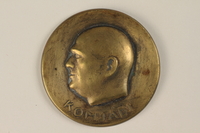
Komjadi commemorative medal owned by a Hungarian Jewish family
Object
Medal depicting Jewish Hungarian Bela Komjadi, awarded to a cousin of Eva Hevesi Ehrlich by the Hungarian Swimming Association in 1934. Known as “the father of Hungarian water polo,” Komjadi established a program resulting in numerous European and Olympic gold medals. Eva was living in Budapest, Hungary, with her parents, Ferenc and Magda Hevesi, when the war in Europe began in September 1939. Ferenc was a rabbi at the Dohány Street synagogue under his father, Simon Hevesi, who was chief rabbi of Hungary. When Simon died in 1943, Ferenc and a colleague succeeded him as co-chief rabbis. Hungary was allied with Germany, but when the Hungarian government began seeking a ceasefire with the Allies, the German army occupied Hungary on March 19, 1944. When the radically antisemitic, German-backed Arrow Cross Party took control of the government on October 15, Eva and her family went into hiding. The section of the city they were in was liberated by the Soviet army on January 16, 1945. Eva’s paternal grandmother had starved to death during the occupation, her maternal grandmother died shortly after liberation, and her fiancé was shot and thrown into the Danube River. Ferenc became a chaplain for the Hungarian army, and returned to his former rabbinical duties. Eva returned to college and met a Hungarian-American soldier with the American military mission. In the fall of 1946, Eva immigrated to the United States with her husband, followed shortly by her father and mother. Eva and her husband divorced in 1949. She then married Bernard Ehrlich in 1950.
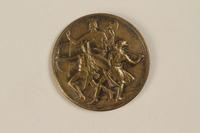
Orszagos Leventeverseny medal owned by a Hungarian Jewish family
Object
Medal for the 1942 Orszagos Leventeverseny (National Levente Competition), awarded to a member of Eva Hevesi Ehrlich’s family. The levente movement provided a framework for government-mandated physical education for Hungarian male youths under 21. It was increasingly militarized, and became controlled by the Ministry of Defense in 1941. A branch for girls was created in June 1942. Eva was living in Budapest, Hungary, with her parents, Ferenc and Magda Hevesi, when the war in Europe began in September 1939. Ferenc was a rabbi at the Dohány Street synagogue under his father, Simon Hevesi, who was chief rabbi of Hungary. When Simon died in 1943, Ferenc and a colleague succeeded him as co-chief rabbis. Hungary was allied with Germany, but when the Hungarian government began seeking a ceasefire with the Allies, the German army occupied Hungary on March 19, 1944. When the radically antisemitic, German-backed Arrow Cross Party took control of the government on October 15, Eva and her family went into hiding. The section of the city they were in was liberated by the Soviet army on January 16, 1945. Eva’s paternal grandmother had starved to death during the occupation, her maternal grandmother died shortly after liberation, and her fiancé was shot and thrown into the Danube River. Ferenc became a chaplain for the Hungarian army, and returned to his former rabbinical duties. Eva returned to college and met a Hungarian-American soldier with the American military mission. In the fall of 1946, Eva immigrated to the United States with her husband, followed shortly by her father and mother. Eva and her husband divorced in 1949. She then married Bernard Ehrlich in 1950.
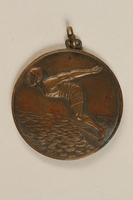
Diving medal owned by a Hungarian Jewish family
Object
Medal for diving, awarded to a cousin of Eva Hevesi Ehrlich in Budapest, Hungary. Eva was living in Budapest, Hungary, with her parents, Ferenc and Magda Hevesi, when the war in Europe began in September 1939. Ferenc was a rabbi at the Dohány Street synagogue under his father, Simon Hevesi, who was chief rabbi of Hungary. When Simon died in 1943, Ferenc and a colleague succeeded him as co-chief rabbis. Hungary was allied with Germany, but when the Hungarian government began seeking a ceasefire with the Allies, the German army occupied Hungary on March 19, 1944. When the radically antisemitic, German-backed Arrow Cross Party took control of the government on October 15, Eva and her family went into hiding. The section of the city they were in was liberated by the Soviet army on January 16, 1945. Eva’s paternal grandmother had starved to death during the occupation, her maternal grandmother died shortly after liberation, and her fiancé was shot and thrown into the Danube River. Ferenc became a chaplain for the Hungarian army, and returned to his former rabbinical duties. Eva returned to college and met a Hungarian-American soldier with the American military mission. In the fall of 1946, Eva immigrated to the United States with her husband, followed shortly by her father and mother. Eva and her husband divorced in 1949. She then married Bernard Ehrlich in 1950.
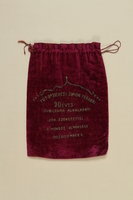
Embroidered purple tallit bag used by two Hungarian rabbis
Object
Embroidered tallit bag, given to Rabbi Simon Hevesi in 1923 and later used by his son Rabbi Ferenc Hevesi, after his death in 1943. Simon became a rabbi in Budapest’s Dohány Street synagogue in 1905. He became a leader in the community and was elected chief rabbi of Hungary in 1927. In 1930, Simon’s son, Ferenc, moved to Budapest with his wife and daughter, and also became a rabbi at the Dohány synagogue. During his tenure in Budapest, Simon founded or served as a board member of numerous institutions and organizations, and was a prolific writer and editor of Jewish scholarly works. When Simon died in 1943, Ferenc and a colleague succeeded him as co-chief rabbis. Hungary was allied with Germany, but when the Hungarian government began seeking a ceasefire with the Allies, the German army occupied Hungary on March 19, 1944. When the radically antisemitic, German-backed Arrow Cross Party took control of the government on October 15, Eva and her family went into hiding. The section of the city they were in was liberated by the Soviet army on January 16, 1945. Ferenc became a chaplain for the Hungarian army, and returned to his former rabbinical duties. In the fall of 1946, Ferenc traveled to England and the United States, where he Anglicized his name to Francis. He gave speeches on behalf of the Hungarian Jewry, and presided over his daughter’s religious wedding ceremony in New York City. Before he and his wife could return home, they were warned that Francis would be persecuted. They stayed in the US where Francis became rabbi for a succession of congregations in Georgia and Hawaii.
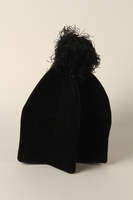
Cantor’s black tufted hat worn by a Hungarian rabbi
Object
Cantor’s hat worn during services by Rabbi Ferenc Hevesi, who served as co-chief rabbi of Hungary between 1943 and 1946. The cantor (hazan or chazzan) is the synagogue’s professional prayer leader. Ferenc joined the Dohany Street synagogue as a rabbi when he moved with his wife, Magda, and daughter, Eva, to Budapest in 1930. When his father, Rabbi Simon Hevesi, died in 1943, Ferenc succeeded him as co-chief rabbi of Hungary. Hungary was allied with Germany, but when the Hungarian government began seeking a ceasefire with the Allies, the German army occupied Hungary on March 19, 1944. Afterward, Ferenc and his family were forced out of their apartment into one shared with other families. A curfew was imposed on Jews and Ferenc could only hold services at the synagogue if it did not conflict with the curfew. As chief rabbi, Ferenc was constantly harassed by the Germans, and pressured to become part of the Judenrat, which he refused. When the radically antisemitic, German-backed Arrow Cross Party took control of the government on October 15, Ferenc and his family went into hiding. The section of the city they were in was liberated by the Soviet army on January 16, 1945. Ferenc became a chaplain for the Hungarian army, and returned to his former rabbinical duties. In the fall of 1946, Ferenc traveled to England and the United States, where he Anglicized his name to Francis. He gave speeches on behalf of the Hungarian Jewry, and presided over his daughter’s religious wedding ceremony in New York City. They stayed in the US, where Francis became rabbi for a succession of congregations in Georgia and Hawaii.
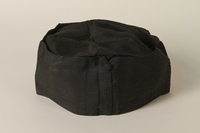
Black yarmulke worn by a Hungarian rabbi
Object
Black yarmulke owned by Rabbi Simon Hevesi, likely acquired in 1939, when he traveled to the United States to receive an honorary doctorate from the Jewish Theological Society of America. A yarmulke is a skullcap worn by observant Jewish males. Simon Handler became an ordained rabbi in 1894, and was appointed chief rabbi in Kassa, Hungary (now Košice, Slovakia) followed by Lugos (now Lugoj, Romania) in 1897. As part of a pilgrimage study trip to Palestine, Simon met the leaders of the Jewish community in Budapest. At their invitation, Simon moved with his wife and five children to Budapest in 1905 and changed their last name to Hevesi. As a rabbi in the Dohány Street synagogue, Simon became a leader in the community, was a beloved speaker, and held a professorship in oratory at the Rabbinical Institute. He was elected chief rabbi of Hungary in 1927 and became president of the National Rabbinical Association. In 1930, Simon’s son, Ferenc, moved to Budapest with his wife and daughter, and also became a rabbi at the Dohány synagogue. In 1939, Simon traveled to the United States, and was given an honorary doctorate by the Jewish Theological Society of America. During his tenure in Budapest, Simon founded or served as a board member of numerous institutions and organizations, and was a prolific writer and editor of Jewish scholarly works. When Simon died in 1943, Ferenc and a colleague succeeded him as co-chief rabbis.
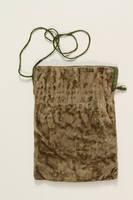
Set of tefillin with a green pouch worn by a Hungarian rabbi
Object
Pair of tefillin and pouch owned by Rabbi Simon Hevesi, and later used by his son, Rabbi Ferenc Hevesi. Simon served as chief rabbi of Hungary between 1927 and 1943. Tefillin are small boxes containing prayers attached to leather straps and worn by Orthodox Jewish males during morning prayers. Simon Handler became an ordained rabbi in 1894, and was appointed chief rabbi in Kassa, Hungary (now Košice, Slovakia) followed by Lugos (now Lugoj, Romania) in 1897. As part of a pilgrimage study trip to Palestine, Simon met the leaders of the Jewish community in Budapest. At their invitation, Simon moved with his wife and five children to Budapest in 1905 and changed their last name to Hevesi. As a rabbi in the Dohány Street synagogue, Simon became a leader in the community, was a beloved speaker, and held a professorship in oratory at the Rabbinical Institute. He was elected chief rabbi of Hungary in 1927 and became president of the National Rabbinical Association. In 1930, Simon’s son, Ferenc, moved to Budapest with his wife and daughter, and also became a rabbi at the Dohány synagogue. In 1939, Simon traveled to the United States, and was given an honorary doctorate by the Jewish Theological Society of America. During his tenure in Budapest, Simon founded or served as a board member of numerous institutions and organizations, and was a prolific writer and editor of Jewish scholarly works. When Simon died in 1943, Ferenc and a colleague succeeded him as co-chief rabbis.
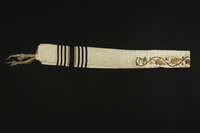
Striped silk tallit worn by a Hungarian rabbi
Object
Tallit owned by Rabbi Ferenc Hevesi, who served as co-chief rabbi in Hungary between 1943 and 1946. A tallit is a specialized shawl worn by Orthodox Jewish males during morning prayers. Ferenc joined the Dohany Street synagogue as a rabbi when he moved with his wife, Magda, and daughter, Eva, to Budapest in 1930. When his father, Rabbi Simon Hevesi, died in 1943, Ferenc succeeded him as co-chief rabbi of Hungary. Hungary was allied with Germany, but when the Hungarian government began seeking a ceasefire with the Allies, the German army occupied Hungary on March 19, 1944. Afterward, Ferenc and his family were forced out of their apartment into one shared with other families. A curfew was imposed on Jews and Ferenc could only hold services at the synagogue if it did not conflict with the curfew. As chief rabbi, Ferenc was constantly harassed by the Germans, and pressured to become part of the Judenrat, which he refused. When the radically antisemitic, German-backed Arrow Cross Party took control of the government on October 15, Ferenc and his family went into hiding. The section of the city they were in was liberated by the Soviet army on January 16, 1945. Ferenc became a chaplain for the Hungarian army, and returned to his former rabbinical duties. In the fall of 1946, Ferenc traveled to England and the United States, where he Anglicized his name to Francis. He gave speeches on behalf of the Hungarian Jewry, and presided over his daughter’s religious wedding ceremony in New York City. They stayed in the US, where Francis became rabbi for a succession of congregations in Georgia and Hawaii.
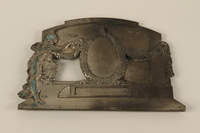
Commemorative silver plaque presented to a Hungarian rabbi
Object
Silver engraved plaque honoring Dr. Simon Hevesi, chief rabbi of Hungary, for his service to the nation’s Jewish community. Simon Handler became an ordained rabbi in 1894, and was appointed chief rabbi in Kassa, Hungary (now Košice, Slovakia) followed by Lugos (now Lugoj, Romania) in 1897. As part of a pilgrimage study trip to Palestine, Simon met the leaders of the Jewish community in Budapest. At their invitation, Simon moved with his wife and five children to Budapest in 1905 and changed their last name to Hevesi. As a rabbi in the Dohány Street synagogue, Simon became a leader in the community, was a beloved speaker, and held a professorship in oratory at the Rabbinical Institute. He was elected chief rabbi of Hungary in 1927 and became president of the National Rabbinical Association. In 1930, Simon’s son, Ferenc, moved to Budapest with his wife and daughter, and also became a rabbi at the Dohány synagogue. In 1939, Simon traveled to the United States, and was given an honorary doctorate by the Jewish Theological Society of America. During his tenure in Budapest, Simon founded or served as a board member of numerous institutions and organizations, and was a prolific writer and editor of Jewish scholarly works. When Simon died in 1943, Ferenc and a colleague succeeded him as co-chief rabbis.
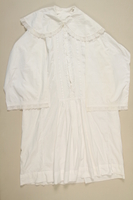
White kittel used by Rabbi Ferenc Hevesi on High Holidays
Object
White kittel with belt for high holiday services, brought by Rabbi Ferenc Hevesi from Budapest, Hungary, to New York City in the fall of 1946. The white color represents the angelic purity that wearers hope to achieve through prayer. Kittels are often worn as burial shrouds, though Ferenc’s unexpected death prevented this. Ferenc joined the Dohany Street synagogue as a rabbi when he moved with his wife, Magda, and daughter, Eva, to Budapest in 1930. When his father, Rabbi Simon Hevesi, died in 1943, Ferenc succeeded him as co-chief rabbi of Hungary. Hungary was allied with Germany, but when the Hungarian government began seeking a ceasefire with the Allies, the German army occupied Hungary on March 19, 1944. Afterward, Ferenc and his family were forced out of their apartment into one shared with other families. A curfew was imposed on Jews and Ferenc could only hold services at the synagogue if it did not conflict with the curfew. As chief rabbi, Ferenc was constantly harassed by the Germans, and pressured to become part of the Judenrat, which he refused. When the radically antisemitic, German-backed Arrow Cross Party took control of the government on October 15, Ferenc and his family went into hiding. The section of the city they were in was liberated by the Soviet army on January 16, 1945. Ferenc became a chaplain for the Hungarian army, and returned to his former rabbinical duties. In the fall of 1946, Ferenc traveled to England and the United States, where he Anglicized his name to Francis. He gave speeches on behalf of the Hungarian Jewry, and presided over his daughter’s religious wedding ceremony in New York City. They stayed in the US, where Francis became rabbi for a succession of congregations in Georgia and Hawaii.
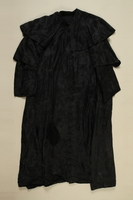
Black robe used by a Rabbi Ferenc Hevesi for everyday services
Object
Black robe with detachable capelet used for everyday religious services, brought by Rabbi Ferenc Hevesi from Budapest, Hungary, to New York City in the fall of 1946. Ferenc joined the Dohany Street synagogue as a rabbi when he moved with his wife, Magda, and daughter, Eva, to Budapest in 1930. When his father, Rabbi Simon Hevesi, died in 1943, Ferenc succeeded him as co-chief rabbi of Hungary. Hungary was allied with Germany, but when the Hungarian government began seeking a ceasefire with the Allies, the German army occupied Hungary on March 19, 1944. Afterward, Ferenc and his family were forced out of their apartment into one shared with other families. A curfew was imposed on Jews and Ferenc could only hold services at the synagogue if it did not conflict with the curfew. As chief rabbi, Ferenc was constantly harassed by the Germans, and pressured to become part of the Judenrat, which he refused. When the radically antisemitic, German-backed Arrow Cross Party took control of the government on October 15, Ferenc and his family went into hiding. The section of the city they were in was liberated by the Soviet army on January 16, 1945. Ferenc became a chaplain for the Hungarian army, and returned to his former rabbinical duties. In the fall of 1946, Ferenc traveled to England and the United States, where he Anglicized his name to Francis. He gave speeches on behalf of the Hungarian Jewry, and presided over his daughter’s religious wedding ceremony in New York City. They stayed in the US, where Francis became rabbi for a succession of congregations in Georgia and Hawaii.
Striped tallit worn by two Hungarian rabbis
Object
Tallit, given to Rabbi Simon Hevesi in 1923 and later used by his son Rabbi Ferenc Hevesi, after his death in 1943. Simon became a rabbi in Budapest’s Dohány Street synagogue in 1905. He became a leader in the community and was elected chief rabbi of Hungary in 1927. In 1930, Simon’s son, Ferenc, moved to Budapest with his wife and daughter, and also became a rabbi at the Dohány synagogue. During his tenure in Budapest, Simon founded or served as a board member of numerous institutions and organizations, and was a prolific writer and editor of Jewish scholarly works. When Simon died in 1943, Ferenc and a colleague succeeded him as co-chief rabbis. Hungary was allied with Germany, but when the Hungarian government began seeking a ceasefire with the Allies, the German army occupied Hungary on March 19, 1944. When the radically antisemitic, German-backed Arrow Cross Party took control of the government on October 15, Eva and her family went into hiding. The section of the city they were in was liberated by the Soviet army on January 16, 1945. Ferenc became a chaplain for the Hungarian army, and returned to his former rabbinical duties. In the fall of 1946, Ferenc traveled to England and the United States, where he Anglicized his name to Francis. He gave speeches on behalf of the Hungarian Jewry, and presided over his daughter’s religious wedding ceremony in New York City. Before he and his wife could return home, they were warned that Francis would be persecuted. They stayed in the US where Francis became rabbi for a succession of congregations in Georgia and Hawaii.
Ferenc Hevesi papers
Document
The collection documents the Holocaust experiences of Rabbi Ferenc Hevesi in Budapest, Hungary, including a fictionalized personal narrative about Ferenc’s wartime experiences, correspondence, a speech, and copyprints. The bulk of the collection consists of a fictionalized account of Ferenc’s wartime experiences in Budapest, titled "Episode, novel by Francis Hevesi." The novel is a three-volume typescript set written in English. Other documents include two wartime letters written to Ferenc describing the situation in Hungary and asking for help locating a missing family member. Both of these letters include English translations provided by the donor. There is also a postwar letter from Ferenc to Bill Stern describing his wartime experience in Budapest, and an annotated copy of a speech given by Ferenc. The photographs consist of seven copyprints depicting the German occupation of Hungary, members of the Ferenc Szálasi-led government and the Arrow Cross party (Nyilaskeresztes Párt), and the arrest of Jewish resister Robert Mandel. There is also a photograph depicting William Vasadi in his kitchen. William was the fiance of Ferenc’s daughter Eva (later Eva Ehrlich) who was murdered by the Arrow Cross in 1944.



